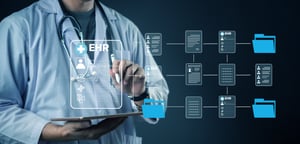End-to-end IT solutions for healthcare organizations.

Unifying the Tech Stack: A Practical Guide for IT Leaders in Healthcare
For IT leaders in mobile healthcare, chaos doesn’t always show up in patient care, it shows up in the backend.
Siloed systems. Duplicate records. Incomplete reporting. And constant requests from operations to “make the tools talk to each other.” When your stack is stitched together with workarounds, every new system becomes another point of failure.
It’s time to move from patching tools to architecting a true platform.
Why the Current Stack Doesn’t Scale
Mobile care delivery introduces complexity that traditional tech stacks weren’t built for, especially when multiple systems (EHR, CRM, scheduling, communication) operate in isolation. That leads to:
- Inconsistent or duplicate data across systems
- Missed updates and routing gaps
- Limited visibility into performance metrics
- High compliance risk with no centralized governance
- Disconnected scheduling and communication
Many healthcare orgs are running on what looks like a “stack,” but functions more like a series of disconnected apps. That’s not sustainable at scale and can often lead to frustration and burnout within teams.
What a Healthy Tech Stack Looks Like
A modern, scalable tech stack for mobile wound care is:
- Interoperable – built on APIs and integrations, not exports and uploads
- Automated – reducing manual inputs across scheduling, intake, and routing
- Mobile-first – designed to support field-based care delivery
- Secure and compliant – with data governance, auditability, and HIPAA baked in
It’s not just about the tools—it’s about how those tools are connected.
How to Unify Your Core Systems
We help organizations build an integrated framework that includes:
- Field service management tools like Salesforce Field Service or Zuper to manage real-time scheduling, routing, and operations
- EHR integration to streamline documentation, visits, and handoffs
- CRM platforms like HubSpot, Salesforce, or Microsoft Dynamics for intake and referral management
- Custom APIs to maintain data integrity and eliminate manual work
- Governance rules to enforce HIPAA compliance and control access
You don’t need to rebuild your whole stack, you need a smarter way to connect what you already use.
A Scalable Ecosystem Starts Here
At Provisions Group, we’ve helped mobile care organizations move from reactive IT to strategic infrastructure- integrating scheduling, care delivery, and communication into a single, secure foundation.
If your tech stack is slowing you down, contact us today or see how we created visibility across scheduling, referrals, and performance metrics for a client on our featured mobile wound care success story.
